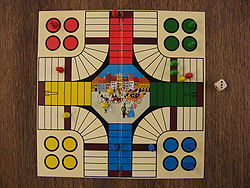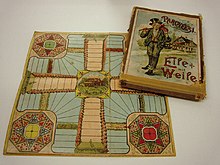Haste makes waste
| Haste makes waste | |
|---|---|
 Assembled game board |
|
| Game data | |
| Publishing year | Late 19th century |
| Art | Board game |
| Teammates | 2 to 4 / to 6 |
| Duration | about 30 minutes |
| Age | from 5 years |
Hurry up with a while (French-speaking Switzerland: Hâte-toi lentement , Italian-speaking Switzerland and Northern Italy: Chi va piano va sano! ) Is a board game that is mainly known in Switzerland . There it is even considered to be one of the most famous board games. It is a variant of Pachisi and thus related to the German game Mensch ärgere dich nicht .
There are game boards for up to four players and even for up to six players - but the latter are rare and sometimes found on the back of the board of four. The games with game boards on cardboard are now often sold with a Mühle game or a Halma on the back.
At the same time, hurry is an oxymoron , i.e. a rhetorical stylistic device made up of two terms with opposing meanings, known as a phrase .
origin
Eile mit Weile is a modification of the ancient Indian game Pachisi and is closely related to the Spanish Parchís , the Colombian Parqués and the American Parcheesi .
The game Pachisi was created in the 6th century. Hurry with a while is much less tactically and strategically worked out than the original Pachisi . The rules have been greatly simplified.
A legend reports that in the 16th century the Mughal Mughal Akbar I is said to have played the game outdoors with sixteen harem slaves instead of normal pawns on a large marble game board.
The game first came to Europe with the British from India in the 19th century and then to the USA. Around 1863 it was launched in a modified form as the Patcheesi (later Parcheesi ) or the Game of India . Towards the end of the century, the Parcheesi in Switzerland and Germany became the game Eile mit Weile . In 1914 Eile was protected by patent law in Germany and Switzerland by the toy factory C. Abel Klinger from Fürth, founded in 1785 (bought in 1972 by the United Altenburger and Stralsunder Spielkartenfabriken AG ), and the registration was renewed in 1918. The game has practically disappeared in Germany today, however, as a new Pachisi descendant became very popular: Mensch ärgere Dich nicht was published by Schmidt Spiele in 1914 and became very popular, especially in Germany. The reason for the diversification in the individual countries could have been trademark law. A slightly modified game could be published without any problems, but the original was not.
Haste with a while seems to be a direct modification of the game Parcheesi, The Game of India , which was published by Selchow & Righter in 1874 and was copyrighted. Game boxes from the turn of the century and the early 20th century often had both game names, “Parcheesi” and “Eile mit Weile”. Earlier boards also have stars in the corners, which can also be found on wood in the first Parcheesi editions.
A peculiarity of the Haste with Time is that the middle often consists of a picture of a hostel or city and the game thus shows the way from home to the city or hostel. It used to mean not only hurry with a while , but also the way to the hostel , careful to the goal or always forward .
Game board
In the middle is a circle or octagon with a picture. The aim is to move all of the pieces into this circle. Four so-called stairs with seven fields in the figure colors lead into this middle field. White and brown fields are arranged around it. White fields are normal train fields and brown fields are called «banks». In earlier game boards, instead of brown fields, small benches were drawn in at these positions. In each of the four corners there are four round starting fields in the figure colors.
Rules of the game
Preliminary round
Two to four players play against each other. They choose a color and place the pieces in the round fields of the same color. The player who rolls the highest number of dice in a drawing round begins.
Moves
When playing the dice, side 6 counts twice and is also called twelve . It is pulled counterclockwise. (Earlier game boards also knew clockwise as the direction of movement.) The players also alternate counterclockwise.
Now the game goes in turn. Each player rolls the die and makes his moves. If a player rolls a twelve , he may roll again. If a player rolls twelve three times in a row, he must put all his pieces that are not yet in the target circle back to their starting position ( “at home” ) and may no longer roll the dice.
If this does not happen, the player can divide the numbers of the individual throws among his pieces. Example: If the player rolls twelve twice and then a five , he can move twenty-four spaces with one piece and bring a new piece into play with the five . However, a figure that is new to the game may not move in the first round.
If numbers cannot be played, they expire. There is a pressure to move: if a player can still move a piece, then he must too.
If the player rolls a five , he must, if he does not have a piece on the playing field or all of his active pieces are blocked, he must place a piece from the starting fields on the board. The first playing field is always the bench between the starting fields and your own stairs. If he already has a piece on the playing field, he can decide whether he comes into play with a new piece or moves an already active piece.
Beat pieces
Opposing pieces (pieces) can be captured on white fields. If a different colored token ends up on an occupied field, the token located there is captured. All overtaken opposing pieces are also considered to have been taken and must return to the starting fields.
If a piece is on a bench (brown playing field), it cannot be captured.
A defeated piece is "sent home", ie returned to its starting position.
Build blockages
If two figures of the same color stand on a field (bench or white field), they set up a blockade. This blockade is binding for all game pieces, including the pieces of the player who set up the blockade. The blockage remains until the player moves a piece or has to move away. There can therefore never be more than two figures on a square with a blockade. A blockade ends when the player pulls away a figure that was forming a blockade.
Stairs and goal
The stairs are taboo for figures of different colors. Each player has to reach the goal via his own stairs. However, a figure can only enter the target with an exactly matching number. Is z. B. the figure on the last field of stairs, a one must necessarily be rolled.
The figures on the stairs must also be returned to their starting spaces at three times twelve . Only the figures in the target space are spared this action.
If a player misses his flight of stairs, for example because he is eager to capture another piece, he has to do a lap of honor. This can actually happen in the course of the game with inattentive players.
The winner is the player who has brought all of his pieces to the finish. Most of the time, the remaining players continue to play until a complete ranking from winner to loser has been established.
Demarcation
It is not entirely clear from the rules of the game whether two opposing pieces may meet on a bench. This is not allowed at the Parcheesi . However, this is not explicitly stated in the rules of the game for “a bit of a hurry”. It is therefore often played in such a way that several opposing pieces can stand on one bench. Therefore, a blockade on a bench can still have an opposing figure if it was already on this space before the blockade was formed.
variants
Modern variant in Switzerland
Since the 1980s, a variant of the game has emerged: Here pieces are not captured by moving a piece onto a white space of an opposing piece, but only by overtaking it. This can now be done in a pull or two. In one move, all opposing pieces are returned home on white squares that are between the starting square and the target square of the piece you moved. If a figure moves onto a space of the opponent's figure, it stops and can be moved on in the next move. But if it stayed where it was and the attacking figure passed it on the second move, the opposing figure was also overtaken and must be put back.
The blockades were also changed: a blockade is only binding for those opposing pieces that were not on the blocked field when the blockade was set up. Opposing pieces can now be moved to the blocked space, but they cannot be moved any further. Likewise, the commitment is often set differently: a blockage is non-binding for the figures of the same color.
The six rolled in some of the new game instructions is a six and not a twelve as in the earlier rules of the game.
Variant of Carlit
The Carlit game available today has a rule attached that lacks the rule of “overtaking” that has been in force for at least a century. Likewise, on this box there is no longer “Chi va piano va sano” as an Italian name, but “Pachisi” as the Indian original. These changes are likely due to a lack of care on the part of the manufacturing company.
Web links
Individual evidence
- ↑ "Chi va piano va sano!" In: Erwin Glonnegger : The games book. Board and placement games from all over the world - origins, rules and history. New edition of Drei Magier Verlag, Uehlfeld 1999; P. 16. ISBN 3-9806792-0-9 .
- ^ David Parlett : The Oxford History of Board Games. Oxford University Press, Oxford et al. 1999, ISBN 0-19-212998-8 .
- ↑ HW Jany: Superficial. Letter to the editor from HW Jany, board member of ASS AG, in spielbox 3/1986, June / July 1986; P. 4.
- ↑ a b Erwin Glonnegger : The games book. Board and placement games from all over the world. Origin, rules and history. Maier et al., Ravensburg et al. 1988, ISBN 3-473-42601-6 .
- ↑ a b Instructions for use (PDF) from the Swiss Association of the Blind, accessed on November 10, 2007.
- ↑ Included instructions from Carlit , Würenlos, 2007.


